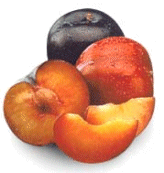|
FRUIT LIST LINKS
|
PLUMS The plant nursery has closed for retirement. We thank you for your pratronage through the last 26 years. Bill Ford is available for consultation and presentations. Please feel free to use the following pages for reference. Happy gardening! AU Producer
Zones 5-8. (700 chill hours) Queen Rosa Queen Rosa is a lightly freckled, dark red/purple plum with juicy, mild, light amber flesh. When cooked or raw it has a tangy flavor, but leaving the skin on adds some sweetness to the cooked fruit. Ripens late June. Zones 5-9. (550 chill hours.) European
Bluebyrd Released by USDA in 1998, Bluebyrd is an excellent European type plum for home garden use. The fruit is blue with amber flesh, medium to large in size with excellent flavor and high sugar content. The tree is vigorous, productive and needs a pollinator. Zones 5-7. (700 chill hours) Stanley This European variety is often grown mainly for drying, but is also good fresh and canned. The deep purple oblong fruit is freestone with yellow flesh. A self-pollinating variety, it is a heavy bearer and ripens early September. Late blooming for frost protection. Zones 5-7. (700 chill hours) Planting Information What a great summer treat to eat a plum straight off the tree – juicy and sweet! Plums have been grown and cultivated for centuries and were even included in the Hanging Garden of Babylon, and are used in all sorts of recipes from fresh in salads and ice creams, to cooked in jams, jellies, chutneys, pastries and sauces.
Plums require full sun, well drained and moderately fertile soil on high ground or ground that is not in a frost pocket to avoid late spring frosts. Japanese plums ( the round juicy type in the grocery stores ) require cross pollination with another variety to ensure better crops unless noted as self-pollinating. European plums ( oval and blue ) are self-pollinating. Set trees out with Orchard Starter Tablets, and in succeeding years fertilize with a complete fruit fertilizer. Bearing begins a 2-3 years. Recommended spacing is 16-18 ft.
|
|
